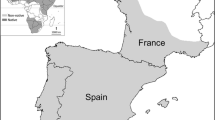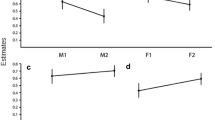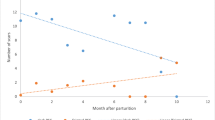Abstract
The ocelotLeopardus pardalis Linnaeus, 1758 is an endangered felid in the United States currently restricted to southern Texas. The objectives of our study were to obtain data on ocelot parturition dates, fecundity, sex ratios, den characteristics, and first year survival, all of which are critical in development of population viability models. Sixteen parturition events were recorded ranging from mid-April to late December for 12 wild ocelots. Cumulatively, litters consisted of 1 or 2 kittens (¯ = 1.2 ± 0.44 SD). Cumulative sex ratio was 1∶2.5 (male:female); however, there was no significant difference between the observed sex ratio and a 1∶1 sex ratio. Ten den sites were in close proximity (≤ 10 m) to dense thornshrub. Adult female ocelots used 2 to 4 den sites for each litter with distance between consecutively occupied dens ranging from 110 to 280 m (¯ = 158 m ± 93 SD). An estimated annual survival for ocelots 0 to 1 year of age was 0.68. Evidence suggests that ocelots in the wild may breed more frequently than had been previously hypothesized.
Similar content being viewed by others
References
Bailey T. N. 1979. Den ecology, population parameters, and diet of eastern Idaho bobcats. [In: Bobcat research conference proceedings. L. G. Blum and P. C. Escherich, eds]. National Wildlife Scientific and Technical Series, no. 6: 62-69.
Blair W. F. 1950. The biotic provinces of Texas. Texas Journal of Science 2: 97–117.
Blankenship T. L. and Swank W. G. 1979. Population dynamics of the bobcat in Texas. [In: Bobcat research conference proceedings. L. G. Blum and P. C. Escherich, eds]. National Wildlife Scientific and Technical Series, no. 6: 116-122.
Cisin C. 1967. Especially ocelots. Harry G. Cisin, New York, N.Y.: 1–167.
Eaton R. 1977. Breeding biology and propagation of the ocelot (Leopardus [Felis]pardalis). Zoologische Garten 1: 72–81.
Eaton R. 1984. Survey of smaller felid breeding. Zoologische Garten 54: 101–120.
Emmons L. H. 1988. A field study of ocelots (Felis pardalis) in Peru. Revue d’Ecologie (la Terre et la Vie) 43: 133–157.
Enders R. K. 1935. Mammalian life histories from Barro Colorado Island, Panama. Bulletin of the Museum of Comparative Zoology, Harvard 78: 385–502.
Fagen R. M. and Wiley K. S. 1978. Felid paedomorphosis, with special reference toLeopardus. Carnivore 1: 72–81.
Fritts S. H. and Sealander J. A. 1978. Diets of bobcats in Arkansas with a special reference to age and sex differences. The Journal of Wildlife Management 42: 533–539.
Haines A. M., Tewes M. E. and Laack L. L. 2005. Survival and sources of mortality in ocelots. The Journal of Wildlife Management 69: 255–263.
Hall E. R. and Dalquest W. W. 1963. The mammals of Veracruz. University of Kansas Publications. Museum of Natural History 14: 165–362.
Hatfield K. and Hatfield J. 1973. Domestic breeding at the Hatfield Compound. Long Island Ocelot Club Newsletter 17: 8–9.
Heisey D. M. and Fuller T. K. 1985a. Evaluation of survival and cause-specific mortality rates using telemetry data. The Journal of Wildlife Management 49: 668–674.
Heisey D. M. and Fuller T. K. 1985b. MICROMORT user’s guide. Minnesota Department of Natural Resources Forest and Wildlife Population and Research Group, Grand Rapids, USA.
Hemker T. P., Lindzey F. G., Ackerman B. B. and Button A. J. 1986. Survival of cougar cubs in a non-hunted population. [In: Cats of the world: biology, conservation, and management. S. D. Miller and D. D. Everett, eds]. National Wildlife Federation, Washington, D.C.: 327–332.
Hines J. E. and Sauer J. R. 1989. Program CONTRAST. U. S. Fish and Wildlife Service Technical Report 24: 1-7.
Jahrsdoerfer S. E. and Leslie D. M. Jr 1988. Tamaulipan brushland of the Lower Rio Grande Valley of south Texas: description, human impacts, and management options. U. S. Fish and Wildlife Service Biological Report 88: 36–63.
Knick S. T. 1990. Ecology of bobcats relative to exploitation and a prey decline in southeastern Idaho. Wildlife Monographs 108: 1–42.
Laack L. L. 1991. Ecology of the ocelot (Felis pardalis) in south Texas. MSc thesis, Texas A&I University, Kingsville, Texas: 1–113.
Logan K. A. and Sweanor L. L. 2001. Desert puma: evolutionary ecology and conservation of an enduring carnivore. Island Press, Washington, D. C., USA: 1–390.
Lonard R. I., Everitt J. H. and Judd F. W. 1991. Woody plants of the Lower Rio Grande Valley, Texas. Texas Journal of Science 45: 133–147.
Lonard R. I. and Judd F. W. 1985. Effects of a severe freeze on native woody plants in the Lower Rio Grande Valley, Texas. Southwestern Naturalist 30: 397–403.
Maehr D. S., Land E. D., Roof J. C. and McCown J. W. 1989. Early maternal behavior in the Florida panther (Felis concolor coryi). American Midland Naturalist 122: 34–43.
Mayfield H. 1961. Nesting success calculated from exposure. Wilson Bulletin 73: 255–261.
Mayfield H. 1975. Suggestions for calculating nest success. Wilson Bulletin 87: 456–466.
Mellen J. 1989. Reproductive behavior of small captive cats (Felis spp.). PhD thesis, University of California, Davis, California: 1–168.
Mondolfi E. 1986. Notes on the biology and status of small cats in Venezuela. [In: Cats of the world: biology, conservation, and management. S. D. Miller and D. D. Everett, eds]. National Wildlife Federation, Washington, D. C.: 125–146.
Norwine J. and Bingham R. 1985. Frequency and severity of drought in south Texas. [In: Livestock and wildlife management during drought. R. Brown, ed]. Caesar Kleberg Wildlife Research Institute Press, Kingsville, Texas: 1–19.
Nowell K. and Jackson P. 1996. Wild cats status survey and conservation action plan. IUCN, Gland: 1–382.
Petrides G. A., Thomas B. O. and Davis R. B. 1951. Breeding of the ocelot in Texas. Journal of Mammalogy 32: 116.
Quillen P. 1981. Hand-rearing the little spotted cat or oncilla. International Zoo Yearbook 21: 240–242.
Richardson A. 1995. Plants of the Rio Grande Delta. University of Texas Press, Austin, Texas: 1–440.
Robinette W. L., Gashwiler J. S. and Morris O. W. 1961. Notes on cougar productivity and life history. Journal of Mammalogy 42: 204–217.
Sauer J. R. and Williams B. K. 1989. Generalized procedures for testing hypotheses about survival or recovery rates. The Journal of Wildlife Management 53: 137–142.
Schaller G. B. 1972. The Serengeti lion — a study of predator-prey relations. University of Chicago Press, Chicago, Illinois: 1–460.
Seidensticker J. 1977. Notes on early maternal behaviour of the leopard. Mammalia 41: 111–113.
Sunquist M. E. and Sunquist F. 2002. Wild cats of the world. University of Chicago Press, Chicago, Illinois: 1–452.
Tewes M. E. 1986. Ecological and behavioral correlates of ocelot spatial patterns. PhD thesis, University of Idaho, Moscow, Idaho: 1–128.
Tewes M. E. and Everett D. D. 1986. Status and distribution of the endangered ocelot and jaguarundi in Texas. [In: Cats of the world: biology, conservation, and management. S. D. Miller and D. D. Everett, eds]. National Wildlife Federation, Washington, D. C.: 147–157.
Thornthwaite C. W. 1948. An approach toward a rational classification of climate. Geographical Review 38: 55–94.
Trent T. T. and Rongstad O. J. 1974. Home range and survival of cottontail rabbits in southwestern Wisconsin. The Journal of Wildlife Management 38: 459–472.
U.S. Fish and Wildlife Service. 1982. Endangered and threatened wildlife and plants; endangered status for U.S. population of the ocelot. Federal Registar 47: 31 670–31 672.
Vesey-Fitzgerald D. 1936. Trinidad mammals. Tropical Agriculture 13: 161–165.
Wassmer D. A., Guenther D. D. and Layne J. N. 1988. Ecology of the bobcat in south-central Florida. Bulletin of the Florida State Museum Biological Society 33: 159–228.
Widholzer F. L., Bergmann M. and Zotz C. 1981. Breeding the little spotted cat. International Zoo News 28: 17–23.
Winegarner C. E. and Winegarner M. S. 1982. Reproductive history of a bobcat. Journal of Mammalogy 63: 680–682.
Author information
Authors and Affiliations
Additional information
Associate Editor was Joseph F. Merritt.
Rights and permissions
About this article
Cite this article
Laack, L.L., Tewes, M.E., Haines, A.M. et al. Reproductive life history of ocelotsLeopardus pardalis in southern Texas. Acta Theriol 50, 505–514 (2005). https://doi.org/10.1007/BF03192643
Received:
Accepted:
Issue Date:
DOI: https://doi.org/10.1007/BF03192643




